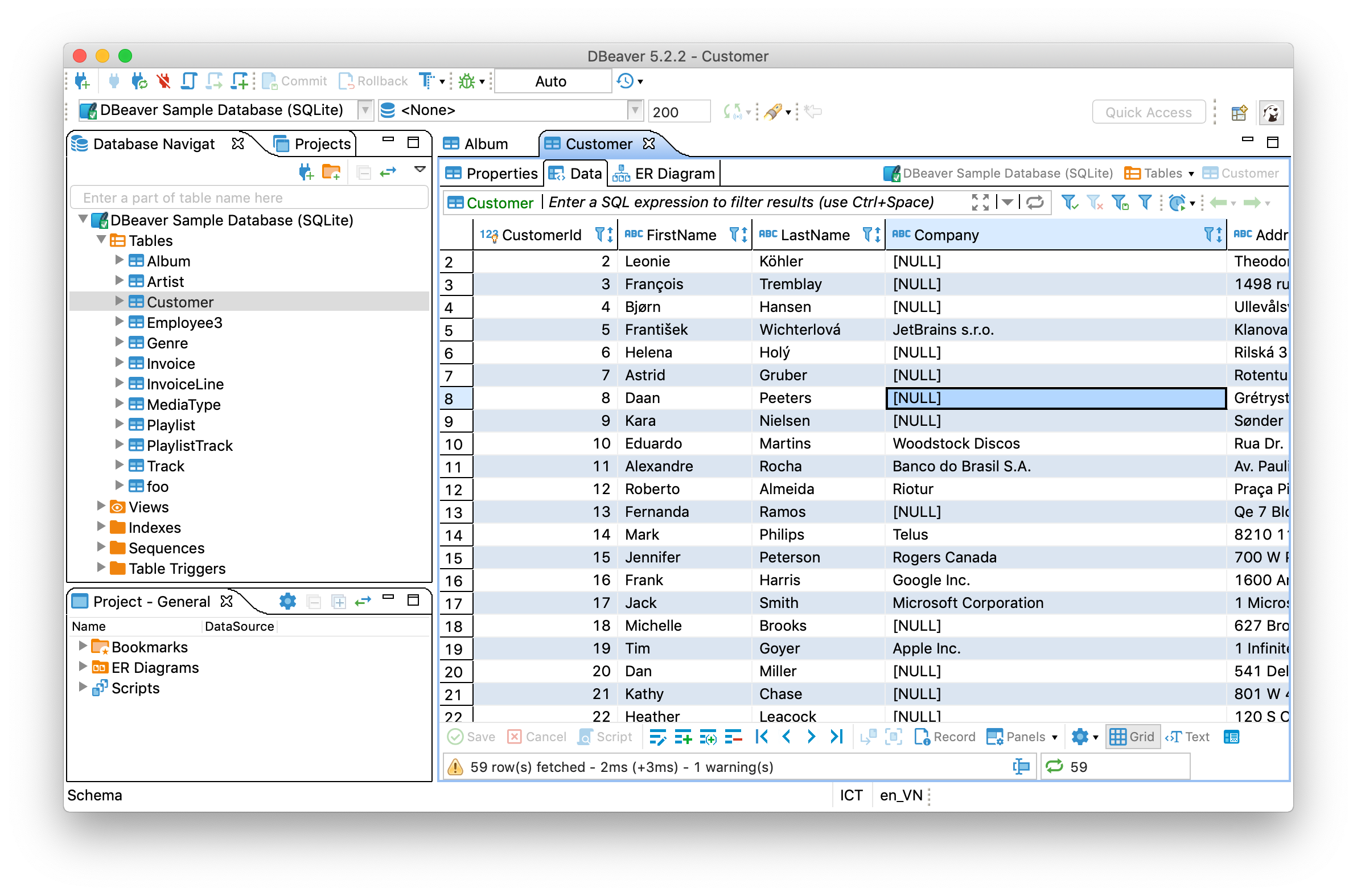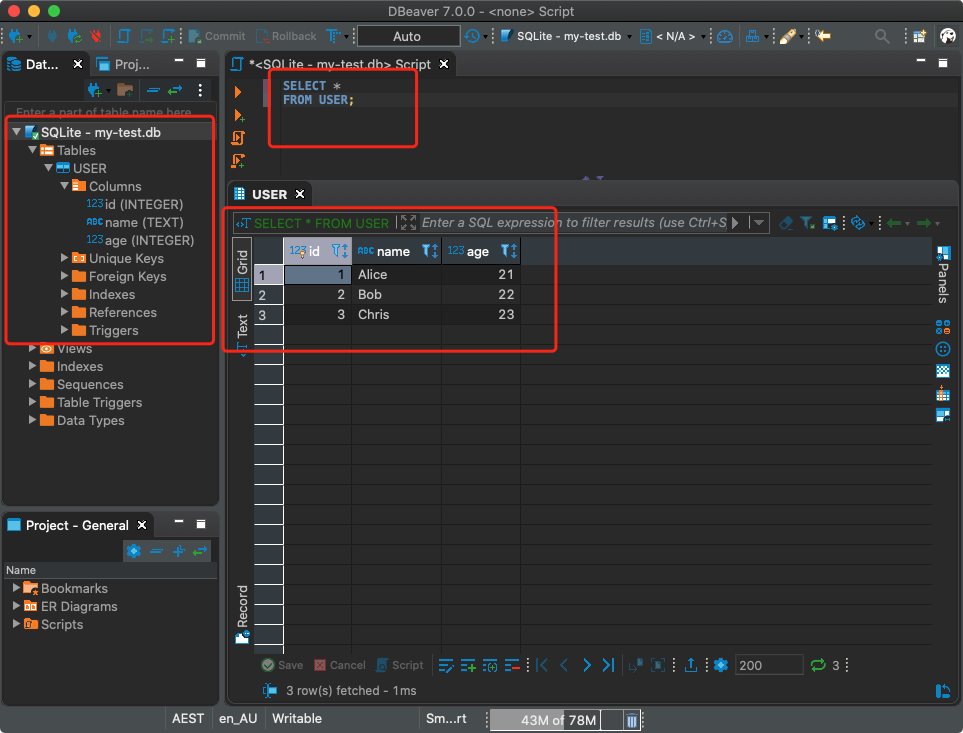At the time of this writing, the latest version is sqlite-jdbc-3.27.2.1.jar. The JAR file includes both Java class files and SQLite binaries for Mac OX S, Linux, and Windows, Both 32-bit and 64-bit. SQLite connection strings. The SQLite JDBC driver allows you to load an SQLite database from the file system using the following connection string. In SQLite, sqlite3 command is used to create a new SQLite database. You do not need to have any special privilege to create a database. 下面介绍一下 DBeaver 客户端工具连接 SQLite 数据库。 1、打开 DBeaver ,点击创建新连接。 有部分人安装后打开可能会遇到下图这种情况,操作栏图标无法.
Summary: in this tutorial, you will learn step by step on how to download and use the SQLite tools to your computer.
Download SQLite tools
To download SQLite, you open the download page of the SQlite official website.
DBeaver is an awesome SQL client and database management tool. It comes with drivers for the most popular databases, including MySQL, PostgreSQL, SQLite and many others, meaning you can learn one tool and use it across projects built on different technology stacks. How awesome is that? DBeaver is one of the best free SQL IDE’s I’ve seen. It has a great UI, it’s fast, and the Projects feature is a helpful way of organising your files and related information. If you’re considering using DBeaver for your SQL work, you can’t go wrong with this choice.
- First, go to the https://www.sqlite.org website.
- Second, open the download page https://www.sqlite.org/download.html
SQLite provides various tools for working across platforms e.g., Windows, Linux, and Mac. You need to select an appropriate version to download.
For example, to work with SQLite on Windows, you download the command-line shell program as shown in the screenshot below.
The downloaded file is in the ZIP format and its size is quite small.
Run SQLite tools
Installing SQLite is simple and straightforward.

- First, create a new folder e.g.,
C:sqlite. - Second, extract the content of the file that you downloaded in the previous section to the
C:sqlitefolder. You should see three programs in the C:sqlite folder as shown below:
First, open the command line window:
and navigate to the C:sqlite folder.
Second, type sqlite3 and press enter, you should see the following output:
Third, you can type the .help command from the sqlite> prompt to see all available commands in sqlite3.
Fourth, to quit the sqlite>, you use .quit command as follows:
Install SQLite GUI tool
The sqlite3 shell is excellent…

However, sometimes, you may want to work with the SQLite databases using an intuitive GUI tool.
There are many GUI tools for managing SQLite databases available ranging from freeware to commercial licenses.
SQLiteStudio
The SQLiteStudio tool is a free GUI tool for managing SQLite databases. It is free, portable, intuitive, and cross-platform. SQLite tool also provides some of the most important features to work with SQLite databases such as importing, exporting data in various formats including CSV, XML, and JSON.
You can download the SQLiteStudio installer or its portable version by visiting the download page. Then, you can extract (or install) the download file to a folder e.g., C:sqlitegui and launch it.
The following picture illustrates how to launch the SQLiteStudio:

Other SQLite GUI tools
Besides the SQLite Studio, you can use the following free SQLite GUI tools:
- DBeaver is another free multi-platform database tool. It supports all popular major relational database systems MySQL, PostgreSQL, Oracle, DB2, SQL Server, Sybase.. including SQLite.
- DB Browser for SQLite – is an open-source tool to manage database files compatible with SQLite.
In this tutorial, you have learned how to download and install SQLite tools on your computer. Now, you should be ready to work with SQLite. If you have any issues with these above steps, feel free to send us an email to get help.
Install SQL Server directly to your Mac — no virtual machine required!
Microsoft has made SQL Server available for macOS and Linux systems. This is made possible by running SQL Server from a Docker container. Therefore, there's no need to install a virtual machine with Windows (which was the only way to run SQL Server on a Mac prior to SQL Server 2017).
Install and Configure Docker

This is a prerequisite for installing SQL Server on your Mac. Because the Mac runs SQL Server inside a Docker container, the first thing we need to do is download and install Docker (unless it's already installed). Once installed, we'll increase its memory allocation to a more suitable level for running SQL Server.
- Download Docker from the download page, extract it, and drag it into your Application folder.
- Launch Docker, and go to
Preferences > Advancedand increase its memory allocation to 4GB
If I've confused you, don't worry. I've written a tutorial with screenshots: Install Docker on a Mac and Configure for SQL Server.
OK, we're now ready to install SQL Server on your Mac.

Now the Actual SQL Server Installation
Now that we've installed Docker and increased its memory allocation, we can go ahead and install SQL Server. The Mac uses the Linux image (the SQL Server for Linux Docker image).
Pull the SQL Server Image
Open a Terminal window and run the following command:*
This pulls the latest SQL Server for Linux Docker image to your computer.
* The exact command will depend on which release you download. Also, since I wrote this article, Docker has moved the repository for SQL Server. You might need to use
docker pull mcr.microsoft.com/mssql/server:2017-latest-ubuntuto download SQL Server 2017.Also, SQL Server 2019 Preview has been available since late 2018. As of late 2019 you can download it at
docker pull mcr.microsoft.com/mssql/server:2019-CTP3.2-ubuntu.For the latest image, see the official Microsoft repository on the Docker website.
Launch the SQL Server Image
Run the following command to launch an instance of the Docker image you just downloaded:
Replace the container name and password with your own. Also be sure to make a strong password, or you may get an error (see below).
Also, if you downloaded a different container image, replace
microsoft/mssql-server-linuxwith your container image.Here's an explanation of the above parameters:
-d- This is an optional parameter that launches the Docker container in daemon mode. This means that it runs in the background and doesn't need its own Terminal window open. You can omit this parameter to have the container run in its own Terminal window.
--name Homer- This optional parameter provides a name for the container. This can be handy when stopping and starting the container from the Terminal.
-e 'ACCEPT_EULA=Y'- The
Yshows that you agree with the EULA (End User Licence Agreement). This is required in order to install SQL Server. -e 'SA_PASSWORD=myPassw0rd'- Required parameter that sets the
sadatabase password. -p 1433:1433- This maps the local port 1433 to port 1433 on the container. This is the default TCP port that SQL Server uses to listen for connections.
microsoft/mssql-server-linux- This tells Docker which image to use. If you downloaded a different one, use that instead.
Password Strength
If you get the following error at this step, try again, but with a stronger password.
Check the Docker container (optional)
Type the following command to check that the Docker container is running.
If it's up and running, it should return something like this:
Show All Containers
The above command only shows those containers that are currently running. To show all containers (whether they're running or not), append the
-aflag to the command (you can also use-all):
Check your Installation & Manage SQL Server
Now that you've installed SQL Server on your Mac, you'll probably want to check that you can access it and query it, etc. Then you'll probably want to start creating databases and doing other DB-related tasks. You'll need some sort of management tool for this.
Dbeaver Sqlite Tutorial
Here are three options:
Dbeaver Sqlite Jdbc Driver Download
sql-cli
sql-cli is a cross platform command line tool for SQL Server. This means you can create databases and query them right from your Mac's Terminal window.
Installation is as easy as running a single command (assuming you already have NodeJs installed).
Azure Data Studio
Azure Data Studio (formerly called SQL Operations Studio) is a free GUI tool from Microsoft. It's a bit more user friendly for those who aren't comfortable with the command line interface.
Installation is as easy as downloading it and dragging it to your Applications folder.
DBeaver
Another GUI option is DBeaver. DBeaver is a free open source database tool that works with many different database management systems (MySQL, PostgreSQL, MariaDB, SQLite, Oracle, DB2, SQL Server, Sybase, MS Access, Teradata, Firebird, Derby, etc).
You have a few options for installing DBeaver. The easiest way is to download the 'installer option', and then run the installation wizard.
